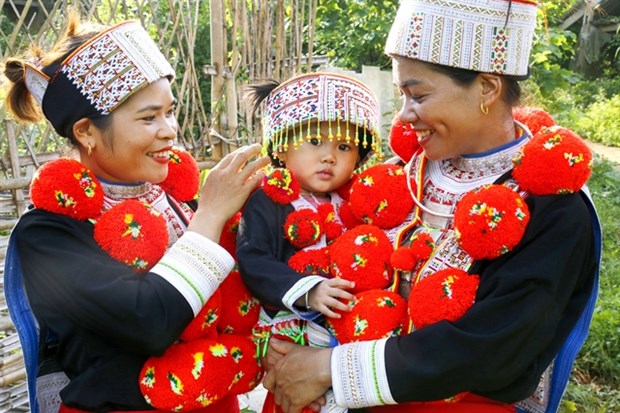Viet Nam moves up four places on 2022 Global Gender Gap Index
Viet Nam has climbed four places on World Economic Forum’s Global Gender Gap Index 2022 in the past year, from 87th to 83rd place out of 146 countries, with a score of 0.705/1.
 |
| Women of Red Dao ethnic minority in their traditional attire. (Photo: VNA) |
The increase is thanks to "mild improvements" recorded in closing the gender gaps across the four main components of the index: Economic Participation and Opportunity, Educational Attainment, Health and Survival, and Political Empowerment.
In terms of closing the gap in Economic Participation and Opportunity, Viet Nam is ranked 31st, behind countries like Sweden (5th), the US (22nd), Kenya (6th), and regional neighbours like Laos (1st), Thailand (15th), or the Philippines (16th), out of 146 countries assessed.
Indicators at this level reveal that lower workforce participation and lower parity in workforce participation have both contributed to poorer gender outcomes, the report said.
“While parity in technical and professional workers has been maintained, the share of women in legislator, senior and manager roles decreased approximately one percentage point. Finally, estimated earned income also fell, in higher proportion for women (-20.7%) than for men (-18.3%).
Viet Nam only ranks in 88th place in terms of Educational Attainment, with the report commenting that the literacy rate increased by 0.005, which, in the absence of data for compulsory education enrolment, raised the sub-index score slightly.
The country is nearly at the bottom of the ranking for Health and Survival sub-index at 141st place (just above Qatar, Pakistan, Azerbaijan, China, and India). In Asia Pacific region, the WEF report noted that “Viet Nam and China have the most progress still to make.”
Marginal improvements in sex ratio at birth in Viet Nam and China have led to an average improvement of the region’s sub-index gender gap score of 0.3 percentage points. Only five countries in this region have achieved gender parity in healthy life expectancy: Mongolia, Viet Nam, Thailand, Myanmar, and the Philippines.
The country is in 106th place in terms of Political Empowerment, with most European countries populating the highest places.
On Political Empowerment, Viet Nam saw a 3.6 percentage points increase in the share of women in parliament, although men continue to hold 100% of ministerial roles, according to the WEF.
Relative to other regions, East Asia and the Pacific registered the second-lowest measure of progress on Political Empowerment, ahead only of Central Asia. The region achieved a 13.3% in gender parity on this sub-index, which is marginally lower than the last edition. Only four countries have closed the gender gap in the share of women in parliamentary positions by at least one percentage point: in order of magnitude of improvement, Viet Nam, Timor-Leste, New Zealand, and Indonesia.
Overall in the East Asia and the Pacific, Viet Nam ranks 9th out of 19 countries assessed, with New Zealand and the Philippines in the top, and Vanuata and Japan at the bottom.
The Global Gender Gap Index benchmarks the current state and evolution of gender parity and is the longest-standing index which tracks progress towards closing these gaps over time since its inception in 2006.
In 2022, the global gender gap has been closed by 68.1%. At the current rate of progress, it will take 132 years to reach full parity, according to the WEF. This represents a slight four-year improvement compared to the 2021 estimate (136 years to parity). However, it does not compensate for the generational loss which occurred between 2020 and 2021: according to trends leading up to 2020, the gender gap was set to close within 100 years.
Although no country has yet achieved full gender parity, the top 10 economies have closed at least 80% of their gender gaps, with Iceland (90.8%) leading the global ranking. Iceland remains the only economy to have closed more than 90% of its gender gap. Other Scandinavian countries such as Finland (86%, 2nd), Norway (84.5%, 3rd) and Sweden (82.2%, 5th) feature in the top 5, with additional European countries such as Ireland (80.4%) and Germany (80.1%) in 9th and 10th positions, respectively.
Sub-Saharan African countries Rwanda (81.1%, 6th) and Namibia (80.7%, 8th), along with one Latin American country, Nicaragua (81%, 7th), and one country from East Asia and the Pacific, New Zealand (84.1%, 4th), also take positions in the top 10. Nicaragua and Germany are the new entrants in the top 10 in 2022, while Lithuania (79.9%, 11th) and Switzerland (79.5%, 13th) drop out this year.
Source: VNA